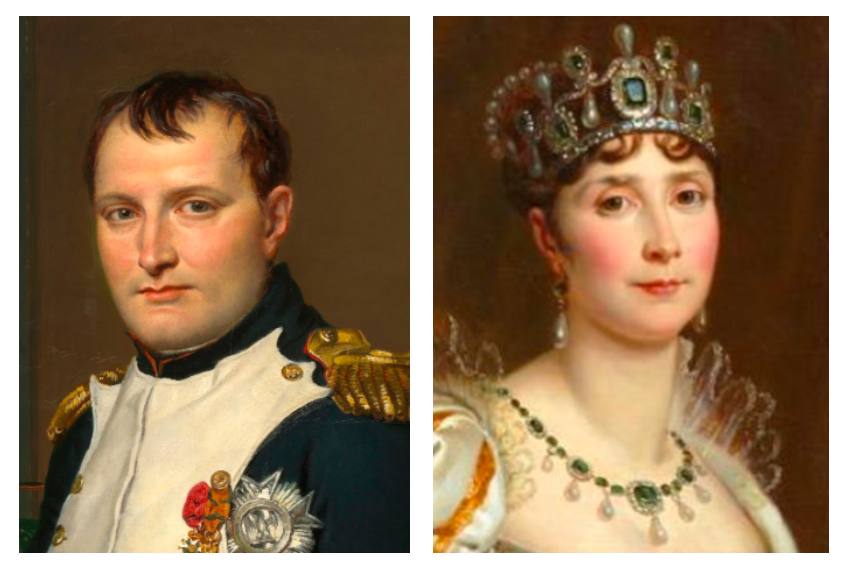If there’s a love story that also features tea, the most famous would be of Napoleon and Josephine. She was 32 (widowed and a mother of two), he was 26 when they first met. Theirs was un amour passionne. Within two months of meeting, they got married (March 1796) and barely two days after the wedding, Napoleon left to lead an army to Italy. He was working towards his great conquest of the world and by the end of the century, had become one of the most powerful men in the world.
But the story of Napoleon and Josephine’s love was more complicated. Their long-distance love was nurtured and kept alive, mostly by Napoleon. His love letters (now published as a volume) reveal a vulnerable and deeply in love young man. (“Write me ten pages. That alone can console me a little.” he writes only a few months after their wedding. “I am nothing without you.” ) Perhaps she missed him less. She took other lovers when he was away. And later, he did too. Still, their marriage endured for some time and in 1804, they were crowned Emperor and Empress of France. What ended the marriage was not the philandering ways of either but that Napoleon needed an heir and his wife couldn’t give him one. And so, the marriage was annulled in 1809 in a ceremony where both Napoleon and Josephine affirmed their devotion to each other.
Napoleon’s other love seems to be for tea sets. He famously carried his samovar to battle, drinking tea before heading to the battlefield. And he displayed his great love for Josephine through tea sets, commissioning them from the Manufacture nationale de Sèvres which was set up in 1740 as the royal manufactory.

Consider this: Three weeks after his divorce, Napoleon wrote to Josephine that he had commissioned a beautiful porcelain service for her. When it arrived, Josephine rejected the porcelain set as being “too severe”. The tea service that came with it had a tea pot with nine tea cups and saucers in a style known as the “Denon-Etruscan form”, in deep blue, decorated with gold hieroglyphics, and with scenes from Egypt. It was later gifted by Louis XVIII in 1818 to Arthur Wellesley, 1st Duke of Wellington.

Another spectacular tea set commissioned by Napoleon is known as the “Tea Service of Famous Women” (Cabaret des femmes célèbres) which has prominent portraits made by Marie-Victoire Jacquetot, one of the early 19th century’s most skilful porcelain painters. This tea service features 16 famous women of the time – “famous for something other than their beauty” – powerful rulers, philosophers, writers and activists, including Queen Elizabeth I and Joan of Arc. The portraiture is a standout feature and Jacquetot is considered a superb miniaturist of her time. This set too, Josephine refused to accept, returning it to the factory! The story goes that Napoleon’s second wife, Empress Marie-Louise chose to gift this set to the Countess of Ségur. The set is now part of The Clark collection.
Between Napoleon and Josephine, and between 1808 and 1813, the manufactory at Sèvres would produce some seven tea services for the couple. Their tea sets have lasted through time, finding their way into museums today. And so has the story of their love. For, despite the tumultuous marriage and divorce, Josephine remained Napoleon’s truest and greatest love.
It seems fitting to narrate their story for this issue of Tea Journey’s Romance + Tea. Every February, we visit the theme of romance and put together a gift guide to celebrate love. This issue’s cover is also inspired by 19th century art. The cover image features “Oriental Tea pots” by British-born American painter Henry Farrer (1843-1903). Farrer moved to New York in 1863 where he worked as a watercolorist. We tried to discover his connection with tea and tea pots but unfortunately his other work and styles seem to dominate the information about him, and the story of his striking tea pots remains a mystery.
In the issue are our romance-themed gifts. They offer something for the romantics, the connoisseurs, the adventurers, the armchair travellers and more. We are sure you will find something to celebrate the season of love here.
Featured image: Sèvres Porcelain Manufactory, Tea Service of Famous Women (cabaret des femmes célèbres), 1811-1812, Image courtesy Clark Art Institute. clarkart.edu
Tea Market
Get More Value from Your Tea: BRU Maker One
+41794574278
Jacque's Organics
(647) 804-7263